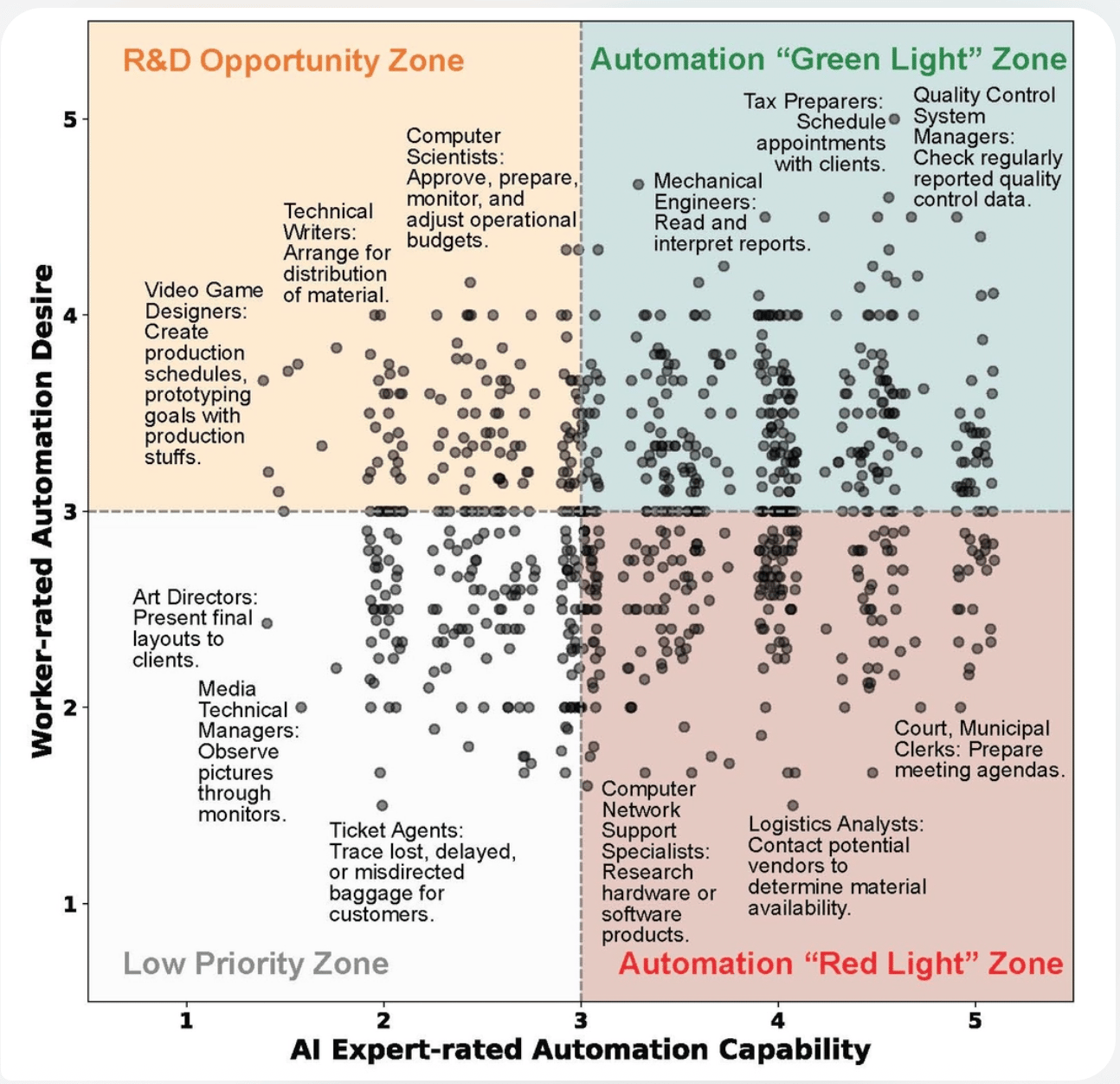- GPTLDR
- Posts
- The Four Zones Framework: Aligning AI Capability with Worker Desire
The Four Zones Framework: Aligning AI Capability with Worker Desire
How to effectively deploy by closing the gap between what employees want and AI's capabilities according to Stanford researchers.
⏱️ Your Morning Brief (TL;DR)
Welcome back!
A groundbreaking new study from Stanford’s Human-Centered Artificial Intelligence Lab (HAI) offers invaluable insights into the current state of AI adoption and worker sentiment.
In today’s brief
What workers are concerned and welcome about AI
A framework for mapping AI use cases
A framework for categorizing human involvement and AI task completion
6 AI related reads
Let’s dive in 🤖
💡 This Week’s Deep Dive
The study underscores a critical disconnect between what employees desire from AI and the reality of its current capabilities, while also revealing significant opportunities for successful integration
😨 Concerns Among Workers
Trust came up as the leading concern between how workers felt about AI, with 45 % doubting its accuracy and reliability, while 23 % fear it could replace their jobs.
🤝Key move: Appoint AI enables, not AI owners. Embrac
🦾 Where AI is Welcome
Workers do welcome automation where it can frees up time for higher-value work (69.4%), reduce task repetitiveness (46.6%), and improve the quality of their work (46.6%).
🪟 The Four Zones of AI Opportunity
The Stanford research mapped AI use cases based on worker desire and AI feasibility, creating a powerful framework for leaders to navigate AI deployment.
Green Light Zone: Tasks with high worker desire for automation and high current AI capability. This is where you can achieve immediate wins and build early worker trust and enthusiasm for AI
R&D Opportunity Zone: Tasks with strong desire for automation/augmentation from workers, but AI is still lagging behind. This zone highlights areas ripe for research and development investment. Leaders should direct their R&D efforts here
Low Priority Zone: These are tasks where workers don't want automation, and the work is difficult for AI to complete. Do not invest resources in automating these tasks.
Red Light Zone: This is the most critical zone. Tasks here can feasibly be done by AI, but workers strongly do not want a computer to take over. Tasks are categories as extremely sensitive tasks where failure carries a high cost.

Source: Stanford University Human-Centered Artificial Intelligence Lab
⚖️ The Human Agency Scale
The human agency scale is a framework introduced by the Stanford team in their study to categorize the level of human involvement and AI assistance in task completion.
The scale ranges from H5 to H1:
H5 (Human Drives Task Completion): Humans take primary responsibility for task execution, with varying levels of AI assistance. This signifies a high degree of human agency.
H3 (Equal Partnership): In the middle of the scale, there is an equal partnership between the human and the AI where both contribute significantly to task completion.
H1 and H2 (Agent Drives Task Completion): AI Agents are the force driving task completion.
GPTLDR Takeaways
It’s not binary: There’s a full spectrum of automation, don’t just choose between full automation vs. no automation.
Use the four zones. Guide your AI projects by mapping use cases onto the Stanford study's four quadrant
Engage front line voices: Employees closest to daily workflows and best equipped to identify suitable tasks for automation
Human skills: Skills requiring human interaction, coordination, management, and training will become more important while current high-wage information-processing skills like data analysis may diminish in value as AI capabilities advanc
📚 Interesting Reads
Learn how to make AI work for you
AI won’t take your job, but a person using AI might. That’s why 1,000,000+ professionals read The Rundown AI – the free newsletter that keeps you updated on the latest AI news and teaches you how to use it in just 5 minutes a day.
➜ Until Next Week
As AI agents take on more tasks, some roles will change, but involving employees at every level remains key. The Stanford study shows that listening to worker input and using the four-zone framework helps leaders build trust, spark innovation, and use AI to support—rather than replace—the workforce.
Stay curious,
The GPTLDR Team